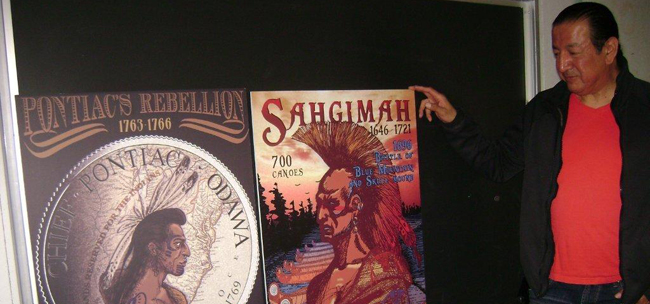Posters bringing warriors to life

By Barbra Nahwegahbow
TORONTO – Artist Philip Cote has heroes, many of them long-forgotten First Nations warriors. Cote has featured them in a series of posters that he hopes will help First Nations people reclaim the “amazing but forgotten role” they played in the history of this country. He unveiled them at a recent exhibition at Fort York National Historic Site in Toronto.
“Our history is not taught in the schools and we are largely absent from mainstream media,” said Cote. “These posters are a counter-narrative to all of that, to bring these heroes to light.” If Cote has his way, warriors like Pontiac, Sahgimah, Tecumseh, Jean Baptiste Cope and Maquinna will soon become household names.
Cote wants to plaster the posters all over the city — “We won’t be asking for permission!” He also wants to see them in every friendship centre and school across the country, “so our people can begin to create a dialogue about their place here.”
The posters are part of his Master’s thesis at Ontario College of Art (OCAD) University. Three years of intense research, drawing, painting and overcoming many obstacles have resulted in a work of which he is justifiably proud. His thesis is centred on Tecumseh and the other “defenders of the people” play a supporting role.
The warriors span a period of some 350 years from 1646 to 2000. Ottawa warrior Sahgimah is the earliest and Lakota activist Russell Means the most recent. The newcomers kept expanding their frontiers, said Cote, breaking treaties.
“We need to celebrate these leaders who rose up to defend their territories.”
In 1696, Sahgimah (c. 1646-1721) was elected to lead a war party against the Haudenosaunee who were invading the hunting territory of the Three Fires Confederacy, an invasion caused by the unrelenting British demand for beaver pelts.
Cote created the feel of an epic movie poster which gives a glimpse of the warrior at sunrise the day of the battle. Sahgimah lead 4,000 warriors in 700 canoes against about 2,000 Mohawks. The battle was in two places – Blue Mountain, the now popular ski resort, and Skull Mound by Lake Erie.
Pontiac, Chief of the Ottawas, organized a combined resistance to the British in the Great Lakes area that became known as Pontiac’s War (1763-64). No images exist of Pontiac, said Cote, who relied on descriptions to create an image of Pontiac on a coin. Pontiac was assassinated when he was in his forties.
Cote, a citizen of Moose Deer Point First Nation, claims descendancy from Tecumseh, the Shawnee Chief and military leader in the War of 1812 who was an important ally of the British forces led by Sir Isaac Brock that defended Canada against American invaders. In his thesis, Cote will deal with all the obstacles he faced trying to find information about Tecumseh.
Cote said the university agreed he needs to tell the story from a First Nations perspective.
“It’s important we have a chance to tell our story without colonial filters.”
The posters, 24×36 on glossy paper, will be available for sale in August. Cote is developing a website for distribution.


